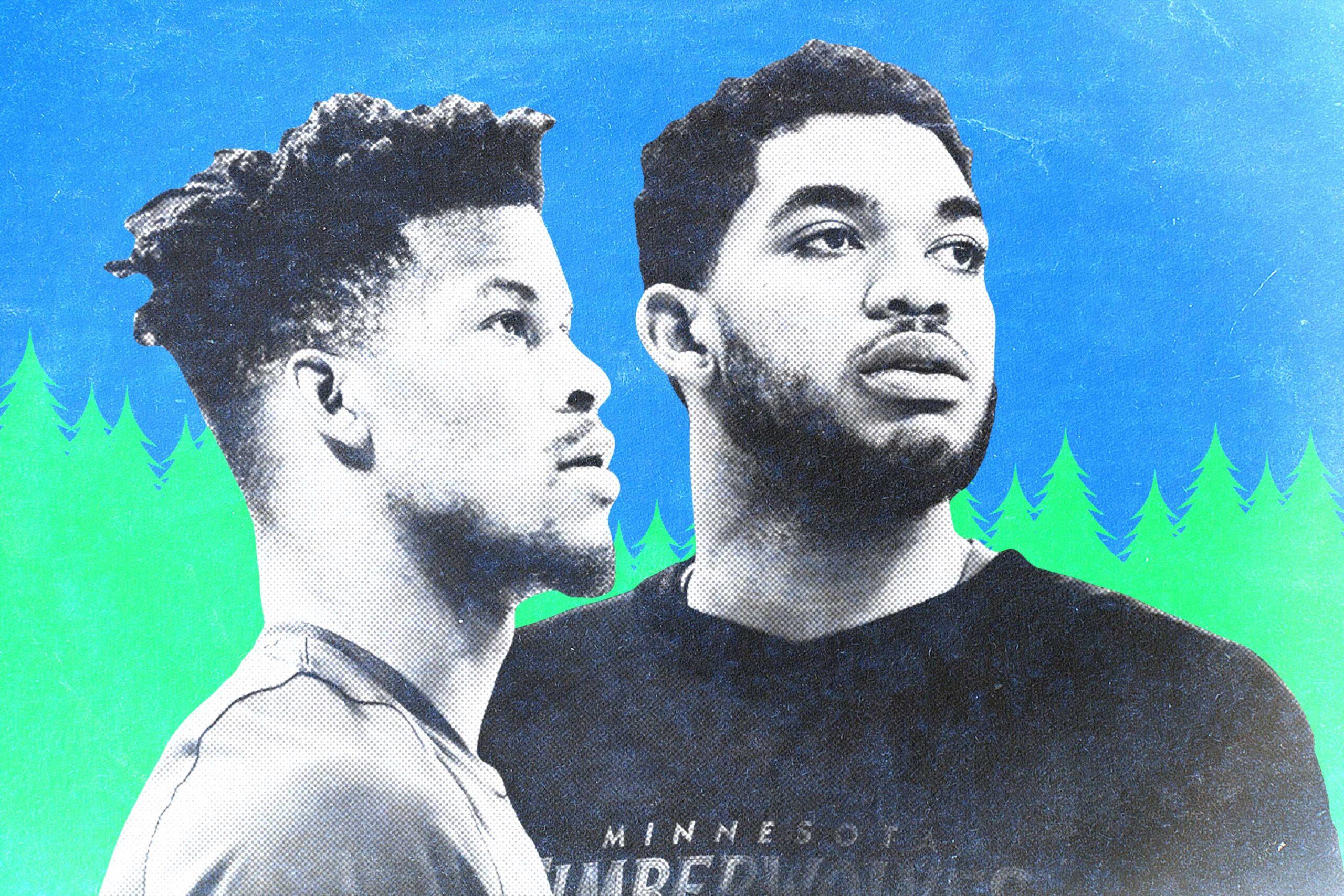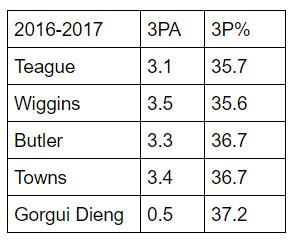Tom Thibodeau’s Wolves Are Now an Old-School Colossus, but Can They Thrive in the Modern Age?
Bigger, stronger, tougher. Minnesota is past the puppy-dog stage. Thibs has built a team loaded with talent, and one that would have been dominant 10 years ago. But is it a sign that his strategies are too rigid?
The Wolves are officially Tom Thibodeau’s team now. In his first season as Minnesota’s coach and president of basketball operations, the team felt strangely unchanged from the defensively-challenged group it had been previously, but things will be different next season. Different, but familiar: Thibodeau has reshaped the roster in his own image over the past few weeks. He acquired two of his former Chicago players (Jimmy Butler and Taj Gibson) and a veteran point guard (Jeff Teague), shipping out Ricky Rubio as well as younger players who weren’t as ready to win now, like Zach LaVine and Kris Dunn, in the process. This was the last offseason where Minnesota would have significant salary cap space, since Andrew Wiggins and Karl-Anthony Towns will be coming up for contract extensions over the next two years, and we now know what their supporting cast will look like for the foreseeable future.
Just like Thibodeau’s Bulls teams, the Wolves will have size and strength at almost every position, but not a lot of 3-point shooting in their starting lineup. In a league getting smaller and faster by the year, Thibodeau has doubled down on being bigger and stronger than his opponents. His strategy should help a team that struggled mightily with defense last season get back to the playoffs, which would break the longest postseason drought in the NBA. However, as was the case with bigger teams like the Thunder and the Grizzlies in last year’s playoffs, the Wolves’ supersize lineups may not be as effective in a seven-game series, when teams can more effectively game plan against specific weaknesses. Minnesota will struggle to space the floor next season:

While four of its starters all shoot at the league average from 3 (35.8 percent), none are the type of elite shooters who command enough gravity to open up the paint. Butler and Wiggins are two of the best slashers in the league, and they will see a lot of defensive coverages similar to what he faced last season in Chicago, when he had to fight through double-teams because he shared the floor with two or three nonshooters. Towns is probably their best 3-point shooter, but Thibodeau will want to run offense through him in the post, where he’s one of the most efficient scorers in the league.
There may not be much small ball in Minnesota’s future, given the investment Thibodeau has made in the frontcourt. He signed Dieng to a four-year, $64 million extension last offseason to start next to Towns in a Twin Towers lineup, he just gave Gibson a two-year, $28 million contract, and he drafted Justin Patton, a 7-footer out of Creighton, with the no. 16 overall pick. While he is reportedly shopping Cole Aldrich, whom he signed to a three-year, $22 million contract last summer, the Wolves will still have as many big men on their roster as any team in the league. Nemanja Bjelica, a 6-foot-10 stretch 4 in his third season, should have a big role this year as well, since his ability to open up the floor will be crucial coming off the bench.
All that size will improve their defense, which was one of the worst in the league last season, despite Thibodeau’s reputation as a defensive mastermind. Minnesota had a defensive rating of 109.1, tied for 26th in the NBA, with Wiggins, Towns, and LaVine all struggling to guard on and off the ball. It doesn’t matter how long and athletic a player is if he consistently loses track of his man, fails to make the proper rotations on the help side, and isn’t communicating properly with the other four players on the floor. The Wolves improved on that side of the ball after LaVine tore his ACL in February, in large part because his absence created more playing time for more experienced players who could cover for some of the mistakes Wiggins and Towns made.
After spending their first few seasons in Minnesota playing on inexperienced teams without the seasoning to compete in the stacked Western Conference, the Wolves’ two young stars will be surrounded by veterans next year. Gibson is 32, Teague is 29, and Butler is 27. Beyond those five, the only other player under the age of 25 currently projected to be in the rotation is backup point guard Tyus Jones. Thibodeau has accelerated the timetable for contention in Minnesota. Expectations are sky-high going into next season. They are no longer a young and fun team growing on the cheap. Once the extensions for Wiggins and Towns kick in, the Wolves are looking at spending significant luxury tax penalties.
Wiggins, the no. 1 overall pick in 2014, will be paid first. He’s one of the best athletes in the league and he has increased his scoring averages every season, but he’s still a raw player with a lot of holes in his game. For a guy who has the ball in his hands as much as he does, he rarely looks to involve his teammates, and he averaged 2.3 assists on 2.3 turnovers a game last season. He’s also an incredibly poor defensive player, with opponents shooting nearly as well with him contesting a shot (56.1 effective field goal percentage) as they do when they are wide open (56.4). Wiggins, like a lot of young high-usage offensive players, struggles to impact the game when he’s not scoring: He barely gets more rebounds, blocks, and steals per 36 minutes of playing time than Jones, one of the smallest and least athletic players in the NBA.
Thibodeau’s additions will be a mixed blessing for Wiggins. On one hand, Butler will get the tougher defensive assignment on the wings, removing some of the pressure from Wiggins on that side of the ball, while providing a strong voice in the locker room who will hold him accountable and push him to improve. On the other, Butler isn’t nearly as good an outside shooter as LaVine, and he will have the ball in his hands a lot more, forcing Wiggins to adjust to a smaller role offensively. He had the freedom to do whatever he wanted last season, and he played with one of the least shot-happy point guards in the league in Rubio. Teague, in comparison, is more of a score-first player, and there will be nights when Wiggins is fourth in field goal attempts, behind Butler, Teague, and Towns. How effective can he be taking 10 shots a game?
Wiggins is 22 and Towns is 21, so they both still have plenty of room to grow. Wiggins has improved as a shooter over the course of his career, boosting his 3-point shooting percentage from 31.0 percent as a rookie to 35.6 percent last season while more than doubling his number of attempts per game from 1.5 to 3.5.
If he can become a knockdown long-range shooter, he can make Butler, Teague, and Towns better without taking the ball out of their hands. For Towns, the biggest area of improvement is his defense. Towns has all the physical tools to eventually anchor an elite defense, which would allow the Wolves to play a more offensively-minded big man like Nikola Mirotic or Patrick Patterson, two guys they did not target in free agency, next to him.
For now, given the limitations of his young stars, Thibodeau will need to figure out how much he should stagger their minutes. Like most old-school coaches, he prefers to keep the same combinations of players together in defined units rather than to make piecemeal substitutions over the course of the game. Wiggins and Towns were second in minutes played among two-man units in the NBA last season, and their starting five of Rubio, LaVine, Wiggins, Towns, and Dieng was the team’s second-most heavily used lineup, even though they played in only 41 games because of LaVine’s injury. Not only would splitting up his starters give each more time with the ball, it would also allow them to play more with shooters like Bjelica, Jones, and Brandon Rush, who would make their lives easier on offense.
Barring a raft of injuries, Minnesota should be able to make the playoffs, even given the arms race happening in the Western Conference. There is just too much talent on the roster, and Thibodeau is too adept at maximizing what he has and grinding out every advantage over the course of an 82-game season, for them not to. Butler is one of the best players in the NBA, while Towns is already in the discussion among the top big men in the league, and they have both been incredibly durable over the course of their careers. The Wolves have an identity: They are big and physical and they are going to make their opponents’ lives miserable. Butler also gives them a closer who can create his own shot in the final minutes of the game, which was a big problem for them last season.
The real challenge will come in the playoffs, when their 3-point shooting and Thibodeau’s flexibility will be tested. He has built a team that would dominate a decade ago, when he won a championship as an assistant coach with the Celtics and the current pace-and-space era of the league was still in its infancy. These days, all roads go through Golden State, and they have proved they can play traditional big men like Dieng and Gibson off the floor in the playoffs. Will Minnesota be able to keep up with a smaller team that spreads the floor, and do the Wolves have enough 3-point shooting to prevent their offense from getting bogged down?
Style of play isn’t the only area where the Wolves are out of step with the rest of the league. Thibodeau is one of the only coaches in the NBA who also holds a prominent front-office position, and the recent track record of guys like Doc Rivers, Stan Van Gundy, and Mike Budenholzer isn’t encouraging. Thibodeau is bringing in a lot of his former players in an effort to win immediately, two of the most common mistakes coaches make when they have full control of shaping a roster. He has been given a rare opportunity to build around two former no. 1 overall picks at the beginning of their careers, and the long-term expectation for a team in that position should be to win championships, not just make the playoffs. Tom Thibodeau has spent his whole life waiting to get in a position like this. He is now on the clock.

